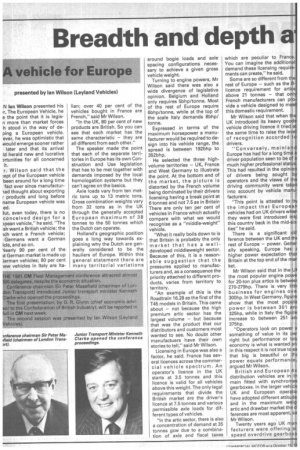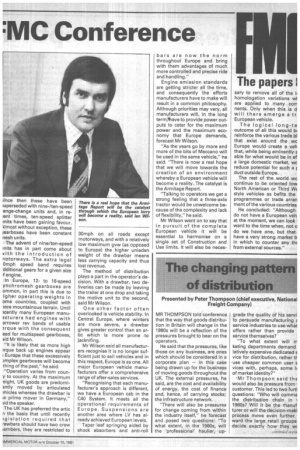Breadth and depth a :MC Conference
Page 20

Page 21

If you've noticed an error in this article please click here to report it so we can fix it.
' presented by Ian Wilson (Leyland Vehicles)
N Ian Wilson presented his The European Vehicle, he e the point that it is legisn more than market forces h stood in the way of deping a European vehicle, ever, he was optimistic that would emerge sooner rather
later and that its arrival Id herald new and lucrative 9rtunities for all concerned it.
r. Wilson said that the :ept of the European vehicle been around for a long time fact ever since manufactursad thought about exporting r products and long before name European vehicle was ed.
3ut, even today, there is no conceived design for a )pean vehicle," he said. "The sh want a British vehicle; the sch want a French vehicle; Germans want a German ice, and so on.
Veerly 90 per cent of the st German market is made up ierman vehicles; 80 per cent sew vehicles in Italy are Ita lian; over 40 per cent of the vehicles bought in France are French," said Mr Wilson.
"In the UK, 80 per cent of new products are British. So you can see that each market has the same characteristic — they are all different from each other."
The speaker made the point that each of the separate territories in Europe has its own Construction and Use legislation that has to be met together with demands imposed by the local homologation systems but they can't agree on the basics.
Axle loads vary from ten metric tons up to 13 metric tons. Gross combination weights vary from 32 tons as in the UK through the generally accepted European maximum of 38 tonnes to the 50 tonnes which the Dutch can operate.
Holland's geographic position goes a long way towards explaining why the Dutch are generally considered to be the hauliers of Europe. Within this general statement there are many territorial variations around bogie loads and axle spacing configurations necessary to achieve a given gross vehicle weight.
Turning to engine powers, Mr Wilson said there was also a wide divergence of legislative opinion, Belgium and Holland only requires 5bhp/tonne. Most of the rest of Europe require 6bhp/tonne, while at the top of the scale Italy demands 8bhp/ to Expressed in terms of the maximum horsepower a manufacturer would be required to design into his vehicle range, the spread is between 192bhp to 352bhp.
He selected the three highvolume territories — UK, France and West Germany to illustrate the point. At the bottom end of the market, the picture is distorted by the French volume being dominated by their drivers licensing having a break point at 6 tonnes and not 7.5 as in Britain There are only ten per cent of vehicles in France which actually compare with what we would recognise as a "middle-weight" vehicle.
"What it really boils down to is that Britain is probably the only market that has a .welldeveloped middleweight sector. Because of this, it is a reasonable suggestion that the pressures applied to manufacturers and, as a consequence the priority attached to different products, varies from territory to territory.
"An example of this is the Roadtrain 16.28 as the first of the T45 models in Britain. This came about — not because the high premium artic sector has the largest volume — but because that was the product that our distributors and customers most wanted to see. No doubt other manufactuers have their own stories to tell," said Mr Wilson.
Licensing in Europe was also a factor, he said. France has several licences across the commercial vehicle spectrum. An operator's licence in the UK starts at 3.5 tonnes and this licence is valid for all vehicles above this weight. The only legal requirements that divide the British market are the driver's licence at 7.5 tonnes and various permissible axle loads for different types of vehicles.
"In the artic sector, there is also a concentration of demand at 35 tonnes gcw due to a combination of axle and fiscal taxes which are peculiar to France. You can imagine the additional demand these licensing requirements can create," he said.
Some are so different from the rest of Europe — such as the Blicence requirement for artics above 21 tonnes — that onl French manufacturers can pro vide a vehicle designed to me this domestic requirement.
Mr Wilson said that when the UK introduced its heavy goods vehicle driving licence it tried at the same time to raise the level of recognition accorded to! drivers.
"Conversely, mainland Europe has had for a long time driver population seen to be of a much higher professional status. This had resulted in the opinion of drivers being sought by operators and the views of the driving community were taken into account by vehicle manufacturers.
"This point is attested to by the impact that European vehicles had on UK drivers when they were first introckiced intc this country back in the mid-six, ties" he said.
There is a significant dif ference between the UK and the rest of Europe — power. Gener ally speaking, Europe has e higher power expectation thar Britain at the top end of the mar ket.
Mr Wilson said that in the the most popular engine powe for 20-ton plus artics is betweer 270-279hp. There is very littlr business for engines ove 300hp. In West Germany, figure show that the most popula power is between 301 am 325hp, while in Italy the figure increase to between 251 an' 375hp.
"Operators look on power a something of value in its ow right but performance or tote economy is what is wanted an in this respect it is not true to sa that big is beautiful or the power equals performance, argued Mr Wilson.
British and European 4x distribution vehicles are in th main fitted with synchromes gearboxes. In the larger vehick UK and European operato! have adopted different attitude and in the maximum weigl artic and drawbar market the d ferences are most apparent, sa Mr Wilson.
Twenty years ago UK man facturers were offering si speed overdrive gearboxe ;ince then these have been iuperseded with nine-/ten-speed ange-change units and, in re:ent times, ten-speed splitter inits have been gaining favour. klmost without exception, these iearboxes have been constant nesh units.
The advent of nine/ten-speed !nits has in part come about uith the introduction of notorways. The extra legal Omph speed band requires dditional gears for a given size f engine.
In Europe, 12to 16-speed ynchromesh gearboxes are ommon, in part this is due to igher operating weights in ome countries, coupled with lore mountainous terrain. Until acently many European menuacturers had engines with arrower rev bands of usable )rque with the consequent eed for multispeed gearboxes, aid Mr Wilson.
"It is likely that as more high )rque back up engines appear !Europe that these excessively )mplex gearboxes will become thing of the past," he said.
"Operation varies from couny to country. At the maximum eight, UK goods are predomi3ntly moved by articulated ahicles whereas the drawbar is le prime mover in Germany," id the speaker.
The UK has preferred the artic the basis that until recently }gislation required that -awbars should have two crew !embers, they are restricted to 30mph on all roads except motorways, and with a relatively low maximum gvw (as opposed to Europe} the higher unladen weight of the drawbar means less carrying capacity and thus lost revenue.
The method of distribution plays a part in the operator's decision. With a drawbar, two deliveries can be made by leaving the trailer at one drop and taking the motive unit to the second, said Mr Wilson.
One other factor often overlooked is vehicle stability. In Central Europe, where winters are more severe, a drawbar gives greater control than an artic which is more prone to jacknifing.
Mr Wilson said all manufacturers recognise it is no longer sufficient just to sell vehicles and in this respect, Europe is as one. All major European vehicle manufacturers offer a comprehensive range of after-sales services.
"Recognising that each manufacturer's approach is different, we have a European cab in the C40 System. It meets all the operational requirements of Europe. Suspensions are another area where LV has already achieved European levels.
Taper leaf springing aided by shock absorbers and anti-roll bars are now the norm throughout Europe and bring with them advantages of much more controlled and precise ride and handling."
Engine emission standards are getting stricter all the time, and consequently the efforts manufacturers have to make will result in a common philosophy.
Although priorities may vary, all manufacturers will, in the long term,tave to provide power out puts to cater for the maximum power and the maximum economy that Europe demands, forecast Mr Wilson.
"As the years go by more and more of the bits of Meccano will be used in the same vehicle," he said. "There is now a real hope that we will move towards the creation of an environment whereby a European vehicle will become a reality. The catalyst is the Armitage Report.
"Talking to operators we get a strong feeling that a three-axle tractor would be unwelcome because of the complexity and lack of flexibility," he said.
Mr Wilson went on to say that in pursuit of the complete European vehicle it will be essential to harmonise on a single set of Construction and Use limits. It will also be neces sary to remove all of the II homologation variations wl are applied to many corr nents. Only when this is d will there emerge a tr European vehicle.
The logical long-te outcome of all this would bi reinforce the various trade bl that exist around the wc Europe would create a veh that, while being eminently s able for what would be in ef a large domestic market, wc reduce potential for such a duct outside Europe.
The rest of the world wc continue to be oriented tow North American or Third Wc style vehicles as befits the programmes or trade arran ment of the various countries He concluded: "Although do not have a European veh at the moment, we can look • ward to the time when, not o do we have one, but that have a very strong market b in which to counter any thr from external sources."
























































